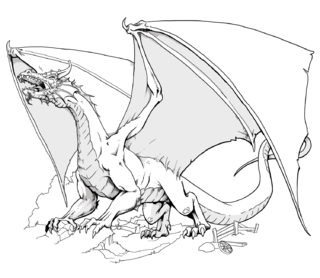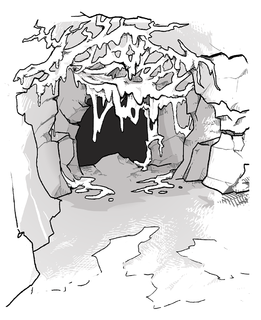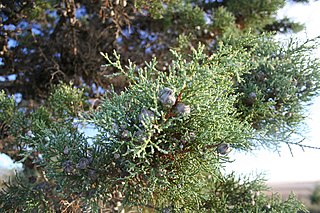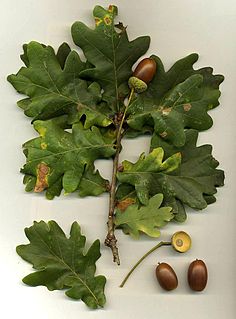
In the Dungeons & Dragons (D&D) fantasy role-playing game, dragons are an iconic type of monstrous creature. As a group, D&D dragons are loosely based upon dragons from a wide range of fictional and mythological sources.

A displacer beast is a fictional creature from the Dungeons & Dragons role-playing game.

In the Dungeons & Dragons fantasy role-playing game, the mimic is a type of fictional monster. It is portrayed as being able to change its shape to disguise its body as an inanimate object, commonly a chest. The mimic has a powerful adhesive that holds fast to creatures who touch the creature, allowing the mimic to beat the creature with its powerful pseudopods. The mimic was introduced in the first edition Advanced Dungeons & Dragons game's original Monster Manual. The mimic has appeared in subsequent editions. Several variants of the creature have been introduced, with a variety of abilities and sizes.

In the Dungeons & Dragons fantasy roleplaying game, the carrion crawler is a type of fictional monster. A carrion crawler is described as a large yellow and green caterpillar-like aberration. The carrion crawler was introduced in the game's first supplement, Greyhawk, in 1975. The carrion crawler subsequently appeared in the first edition Advanced Dungeons & Dragons game's original Monster Manual sourcebook, and then continued to appear in the game's second edition, third edition, and fourth edition.
In the Dungeons & Dragons fantasy role-playing game, an ooze is a type of creature. This category includes such monsters as slimes, jellies, deadly puddings, and similar mindless, amorphous blobs. They can be used by Dungeon Masters as enemies of the player characters.

In the Dungeons & Dragons fantasy role-playing game, nagas comprise a variety of similar species of intelligent aberrations with widely differing abilities and alignments.
In the Dungeons & Dragons fantasy roleplaying game, the choker is an aberration. It can be used by Dungeon Masters as an enemy or ally of the player characters.
In the Dungeons and Dragons fantasy role-playing game, the grick is an aberration. A grick resembles a large, darkly colored worm or snake-like creature. Its beak is ringed by four barbed tentacles, which are its main weapons.
In the Dungeons & Dragons fantasy roleplaying game, a darkmantle is a strange magical beast which lives in caves.

In the Dungeons & Dragons fantasy role-playing game, the roper is a magical beast, resembling a conical structure similar in appearance to rock, wrapped in rope-like tentacles which conceal a mouth. The roper stays very still to resemble a harmless stalagmite, and when prey comes near it lashes out with its tentacled ropes to constrict the prey or pull them back to its mouth.
In the Dungeons & Dragons fantasy role-playing game, the howler is an outsider from planes dominated by evil forces, e.g... the lower planes. It resembles a furless monkey crossed with a sickly dog, and has a vaguely human-like face. It is grey in color, with the slightest hints of violet. For no apparent reason, its shoulders jut sharply up in ugly extremities. Growing along its back and from its front legs, are sharp quills.
Within the world of the Dungeons & Dragons fantasy role-playing game, construct is a type of creature, or "creature type". Constructs are either animated objects, or any artificially constructed creature.

In the Dungeons & Dragons fantasy role-playing game, the gray ooze is an ooze. It resembles a thick, viscous puddle of gray sludge, roughly 6 to 8 inches thick and up to 14 feet across, and often closely resembles wet stone or an amorphous rock formation.

In the Dungeons & Dragons fantasy role-playing game, green slime is an ooze, a category of monster. It is more akin to a plant than an animal. It is a horrible, fetid growth, resembling a bright green, sticky, wet moss which grows on the walls and ceilings of caves, sewers, dungeons, mines, and the like.

In the Dungeons & Dragons fantasy role-playing game, the lurker is an aberration. It is similar to the darkmantle and the piercer, but attacks with suffocation instead of impaling. The Lurker resembles a flat, grey stingray with two small eyes at the front. They are capable of both creeping along a ceiling and slowly gliding through the air. The darkmantle is said to be the result of crossbreeding a lurker with a piercer. Lurkers live underground.

The remorhaz is a magical beast in the Dungeons & Dragons fantasy role-playing game. It is similar to another monster in the game, called the frost worm.
The Dungeons & Dragons fantasy role-playing game contains many monsters that are similar or related to dragons but which are not "true dragons", which are dragons that grow stronger with age. These can be magical beasts, half-dragons, creatures with more distant dragon ancestry, races descending from actual dragons, or creatures of other types, which resemble dragons. Alternatively, they could have the dragon type or keyword, but not be true dragons, or they could have the "dragonblood" subtype in the 3rd edition of Dungeons & Dragons.












